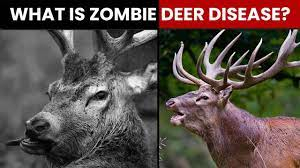Have you heard about the phenomenon of "zombie deer disease" spreading across deer populations? But why the name "zombie"?
Chronic wasting disease (CWD), colloquially known as "zombie deer disease," is a neurodegenerative disorder that afflicts deer, elk, reindeer, sika deer, and moose. This ailment, characterized by abnormal protein folding in the brain and spinal cord, results in severe neurological symptoms akin to dementia, ultimately culminating in death. Despite its ominous nickname, the origins of the term "zombie deer" remain shrouded in mystery.
But what about its transmissibility to humans? While there have been no confirmed cases of CWD transmission to humans, experimental research raises concerns about potential risks, particularly through the consumption of infected meat. Although the World Health Organization advises precautionary measures to prevent prion diseases from entering the human food chain, the likelihood of human infection remains uncertain.
Moreover, CWD isn't confined to deer alone. Studies suggest that certain non-human primates may also be susceptible to the disease, posing broader implications for wildlife and public health. With CWD cases reported across various regions in North America, Europe, and Asia, the disease's reach extends beyond geographical boundaries, necessitating global attention and collaboration in mitigation efforts.
Potential Risks to Human Health
While no confirmed instances of CWD transmission to humans have been documented, lingering concerns revolve around potential interspecies contagion, particularly through the consumption of contaminated meat. Experimental studies have suggested susceptibility in certain non-human primates, sparking debates regarding the transmissibility of CWD. However, existing evidence does not substantiate significant human transmission, though precautions are warranted to avert exposure to infected animals or environments.
Precautionary Measures Against CWD
To mitigate the threat of CWD transmission, health authorities advocate for several preventive measures:
- Thoroughly screen-hunted animals for CWD before meat consumption.
- Exercise caution around sick or deceased deer and elk displaying aberrant behavior.
- Utilize protective gear, such as gloves, when handling deer carcasses or organs.
- Refrain from using household utensils on deer meat to prevent cross-contamination.
- Maintain vigilance for signs of CWD in wildlife populations and promptly report suspected cases to local authorities for further assessment.
Navigating the Complexity of Zombie Deer Disease
As researchers delve deeper into the intricacies of CWD, ongoing surveillance and proactive interventions are imperative to safeguarding both wildlife and human populations. By fostering awareness and implementing preventive strategies, we can fortify defenses against the potential dissemination of this enigmatic disease, thereby preserving the vitality of ecosystems and the well-being of communities worldwide.
